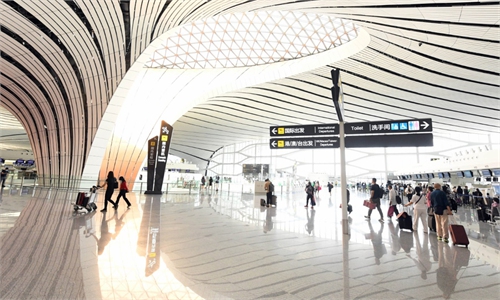Upcoming travel rush highlights urgency of ramping up Chinese rural areas’ preparedness for COVID-19 surge

The travel code, which people in China have used in the course of everyday life tied to travel risks to move around different localities for almost three years since the outbreak of the COVID-19 pandemic, will be removed starting on December 13, 2022. Photo: IC
China announced plans to scrap the national COVID-19 tracking code starting from Tuesday, a move that will further boost domestic travel after the country optimized its COVID-19 response last week. This move, along with the upcoming Chinese New Year, highlighted the urgency of ramping up rural areas' preparedness for COVID-19 outbreaks, said epidemiologists.The travel tracing code will cease to function on Tuesday, and residents' travel will not be traced and recorded. The code was used to show local governments if the new arrivals had visited pandemic hot spots.
The move was announced on Monday, after the Chinese government last week rolled out 10 new measures in optimizing the COVID-19 response, including saying that nucleic acid test results and health codes will no longer be checked for domestic cross-regional travels.
Moreover, the country is about to embrace a travel rush during Chinese New Year, which falls on January 22, 2023. In 2019, when the pandemic started, nearly 3 billion trips were made. Air travels for the 2023 Chinese New Year period will return to 80 percent of the pre-pandemic level, travel platform Qunar predicted on Monday.
Nancy Xu, a resident in Beijing, told the Global Times on Monday that her company allowed employees to go back home after forbidding them from taking trips during the Chinese New Year for the past two years.
"I am both excited and worried. Because in Beijing and other big cities we see caseloads surging after the new measures, I am afraid travels may propagate viral spreading in villages during the Chinese New Year and affect my elderly relatives," said Xu, from a small township in Southwest China's Sichuan Province.
After the 10 new measures ended mass nucleic acid testing and allowed people with no or mild symptoms to home quarantine, cases began to climbing in metropolises such as Beijing, Shanghai and Guangzhou.
Omicron transmits faster, but it has relatively low pathogenicity. If we still use the old way to cope with the Omicron wave, the price will be unbearable, Wu Hao, a national-level disease control expert and public health professor at Capital Medical University in Beijing, told the Global Times on Monday. He said the current emphasis should be to eliminate fear and use limited resources to prevent severe cases and deaths.
Big cities are more capable of coping with case surges as they are equipped with better medical systems and sanitary conditions, Wu said, warning that the rural areas, where most residents are elderly and poorly equipped medically, will bear a stronger onslaught of COVID-19.
To increase rural areas' preparedness, Wu suggested ramping up the vaccination of vulnerable groups ahead of the Chinese New Year. Also, stockpiling COVID-19 medicines and strengthening education for rural dwellers on the coronavirus, to help "reduce their fear."
Similar suggestions were proposed by China's top epidemiologist Zhong Nanshan, who told media last week that a booster shot will take effect in two weeks, and play an effective role in preventing large-scale spreading during the Chinese New Year travel rush.
China's top COVID-19 epidemic control group released a working announcement on Sunday, urging top hospitals in each province should help those in the province's rural areas improve their ability to cope with the surge in COVID-19 cases. The measures include sending medical workers to rural hospitals, and setting up remote networking to assist doctors in counties and villages.
Rural areas should have one doctor and 2.5 to 3 nurses per intensive-care unit (ICU) bed, and add 20 or 30 percent of total medical workers as back-up resources. It also asked 90 percent of village and township hospitals to establish fever clinics by the end of March 2023.
Wu noted that it might be difficult for smaller villages to set up enough ICU beds at such short notice, so they need to transfer patients in need to higher-level hospitals, and the government is making plans to open green channels for such transfers.
The expert also said that the infection wave in big cities may ebb when the Chinese New Year nears, which can free medical workers in the cities to support rural areas in treating patients.
Zhong predicted that latest wave of COVID-19 infections in Guangzhou is likely to peak between early and mid-January and mid-February in 2023, and society will return to pre-epidemic conditions in the first half of 2023.
Nationwide, the outbreak will also peak within one month, and it will take three to six months for China to weather this wave of outbreaks, Caixin magazine on Sunday quoted Zhang Wenhong, head of the infectious disease department at Huashan Hospital in Shanghai, as saying.




